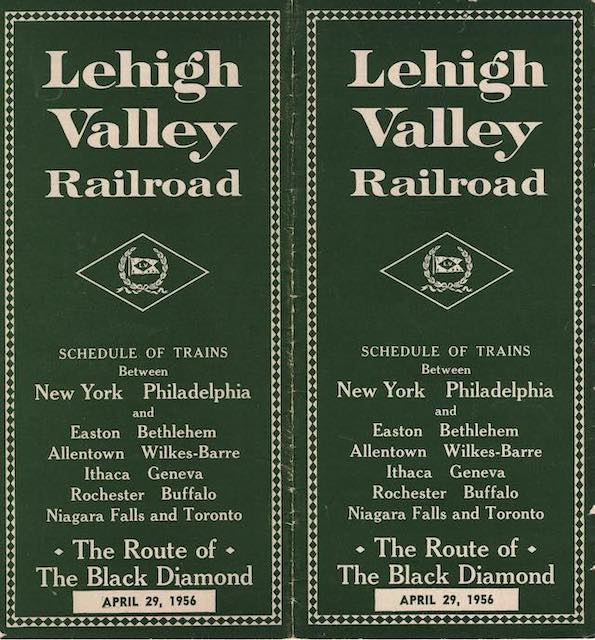With little more than half as many miles of track as the Erie, the Lehigh Valley nonetheless upstaged the mighty New York Central when it opened an impressive Greek revival train station in Buffalo in 1916. The Central’s own stations in Buffalo were relatively pathetic until it opened Central Terminal in 1929.
 Click image to download a 6.2-MB PDF of this timetable contributed by Ellery Goode.
Click image to download a 6.2-MB PDF of this timetable contributed by Ellery Goode.
At the other end of the line, the Lehigh Valley reached the Jersey Central Terminal, which also hosted trains of the Baltimore & Ohio and Reading Railroad. In between, the LV’s line was, at 447 miles, just a dozen miles longer than the Central’s. But because the Lehigh’s route was more mountainous, New York Central trains could get from New York to Buffalo in 7-2/3 hours while Lehigh Valley trains required at least two hours more.
Unlike the Erie, which turned north as soon as it left the Hudson and went west through New York state, the Lehigh Valley crossed New Jersey and half the state of Pennsylvania before heading northwest towards Buffalo. Along the way it served cities such as Bethlehem, Wilkes-Barre, and Ithaca that were skipped by the Central.
LV offered three trains a day between Jersey City and Buffalo, including the daylight Black Diamond and the overnight Maple Leaf (which continued to the Canadian border). The third train, also an overnighter, was called the Star westbound and the Major eastbound. Three other passenger trains only went as far west as Leighton, Pennsylvania.
Although the timetable emphasizes connections to Chicago on the Maple Leaf via Canadian National (Grand Trunk), the railroads did not offer any through cars. “For information only,” the timetable also shows connections at Buffalo with New York Central and Nickel Plate trains to Chicago.
Despite its small size, the Lehigh Valley played two large roles in the history of railroad locomotion. In 1848, Lehigh Valley predecessor Beaver Meadow Railroad introduced the first 4-4-0 locomotive, which would become the most numerous passenger steam locomotive ever built in America. Later, when the Beaver Meadow had consolidated with several other railroads into the Lehigh Valley, the new railroad introduced the 2-8-0 locomotive, known as the consolidation in honor of the merger. Used mainly for freight, the 2-8-0 became the most numerous steam locomotive wheel arrangement ever built.
